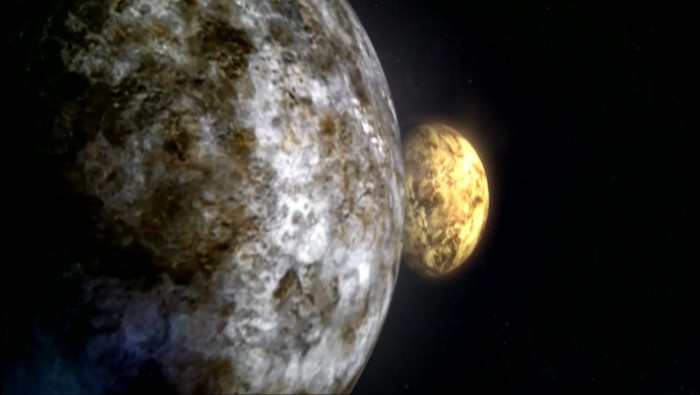History of Moon formation
After the Sun began to shine, the planets of the solar system began to form. But it took about hundreds of millions more years for the Earth's Moon to appear and exist today. There are three main theories about the formation of satellites of the planets: the big collision hypothesis, the hypothesis of the conception and the seizure hypothesis.
Hypothesis of a big collision
This is the prevailing hypothesis of the scientific community. Like other planets, the Earth is made up of residual dust and gas clouds that are orbiting the newly formed young Sun. The early solar system was a chaotic region, and a large number of objects were created but never became a true planet. According to the hypothesis of a big collision, one of those objects hit Earth shortly after the planet was formed.
Called Theia , a Mars-sized object collided with the Earth, blasting away the masses of this young planetary shell into space. Gravity binds these pieces of matter together, forming one of the largest moons in the solar system around its host planet. This type of formation was able to explain why the Moon was made up mainly of light elements, making it less dense than Earth - the material that formed the Moon came mainly from the Earth's crust when they left. Stone core of the early planet. When matter gathers around the rest of Theia's core, they may have gathered near the Earth's zodiacal plane, the Sun's path in the sky, and also where the Moon moves today.

Does our Moon come from a horrific collision between Earth and Theia?
Hypothesis comes together
The Moon can also form at the same time with the planets. According to such an explanation, gravity could have caused material in the early Solar System to aggregate at the same time as gravity pulled the particles together to form Earth. Such a Moon may have a very similar composition to the planet, and could explain the moon's current position. However, although the Earth and the Moon share quite a lot of material together, the Moon's physical density is smaller than our Earth, making this hypothesis not the case of the Face. Moon except when both start with the same heavy element at its core.
Arrest hypothesis
Perhaps the gravity of the Earth has captured a passing object, as it has happened to other moons in the Solar System, such as Mars's Moon Phobos and Deimos. According to the seizure hypothesis, a rock object formed somewhere in the Solar System may have been pulled into orbit around the Earth. The seizure hypothesis can explain the difference in the composition of the Earth and the Moon. However, such a satellite often has an odd shape and not a spherical shape like the Moon. Their path also does not tend to lie on the zodiacal plane of the parent planet, unlike our Moon.
Although the conjecture and conjecture together explain the ingredients that exist on the Moon, they still leave many questions unanswered. Until now, the hypothesis of the big collision seems to answer a lot of questions, making it the best model to match the scientific evidence of how the Moon was made.
- The new discovery supports the hypothesis of the formation of the Moon
- New theory of Moon formation
- New hypothesis about the origin of the Moon
- Water on the Moon and Earth has the same origin
- The unexpected similarity between the moon and Mercury
- Astronomers map the history of the Universe
- The violent evolution of the Moon
- Hypothesis of black plate formation on the Moon
- The moon was formed 4.36 billion years ago
- Couple of spacecraft studying the moon
- Does the Moon have its own moon? And you will be surprised with its name!
- The moon has twice the life and the end of the world!
 Van Allen's belt and evidence that the Apollo 11 mission to the Moon was myth
Van Allen's belt and evidence that the Apollo 11 mission to the Moon was myth The levels of civilization in the universe (Kardashev scale)
The levels of civilization in the universe (Kardashev scale) Today Mars, the sun and the Earth are aligned
Today Mars, the sun and the Earth are aligned The Amazon owner announced a secret plan to build a space base for thousands of people
The Amazon owner announced a secret plan to build a space base for thousands of people What would a day on the Moon be like for astronauts?
What would a day on the Moon be like for astronauts?  First photo of Mars' strangely shaped moon
First photo of Mars' strangely shaped moon  The biggest supermoon of the year is about to light up the world's skies
The biggest supermoon of the year is about to light up the world's skies  New research shows that Earth has a new 'Moon'
New research shows that Earth has a new 'Moon'  James Webb Telescope Discovers Rare Scene From Saturn's Moon
James Webb Telescope Discovers Rare Scene From Saturn's Moon  Shock Detected on the Dark Side of the Moon: Structure Identical to Earth!
Shock Detected on the Dark Side of the Moon: Structure Identical to Earth! 